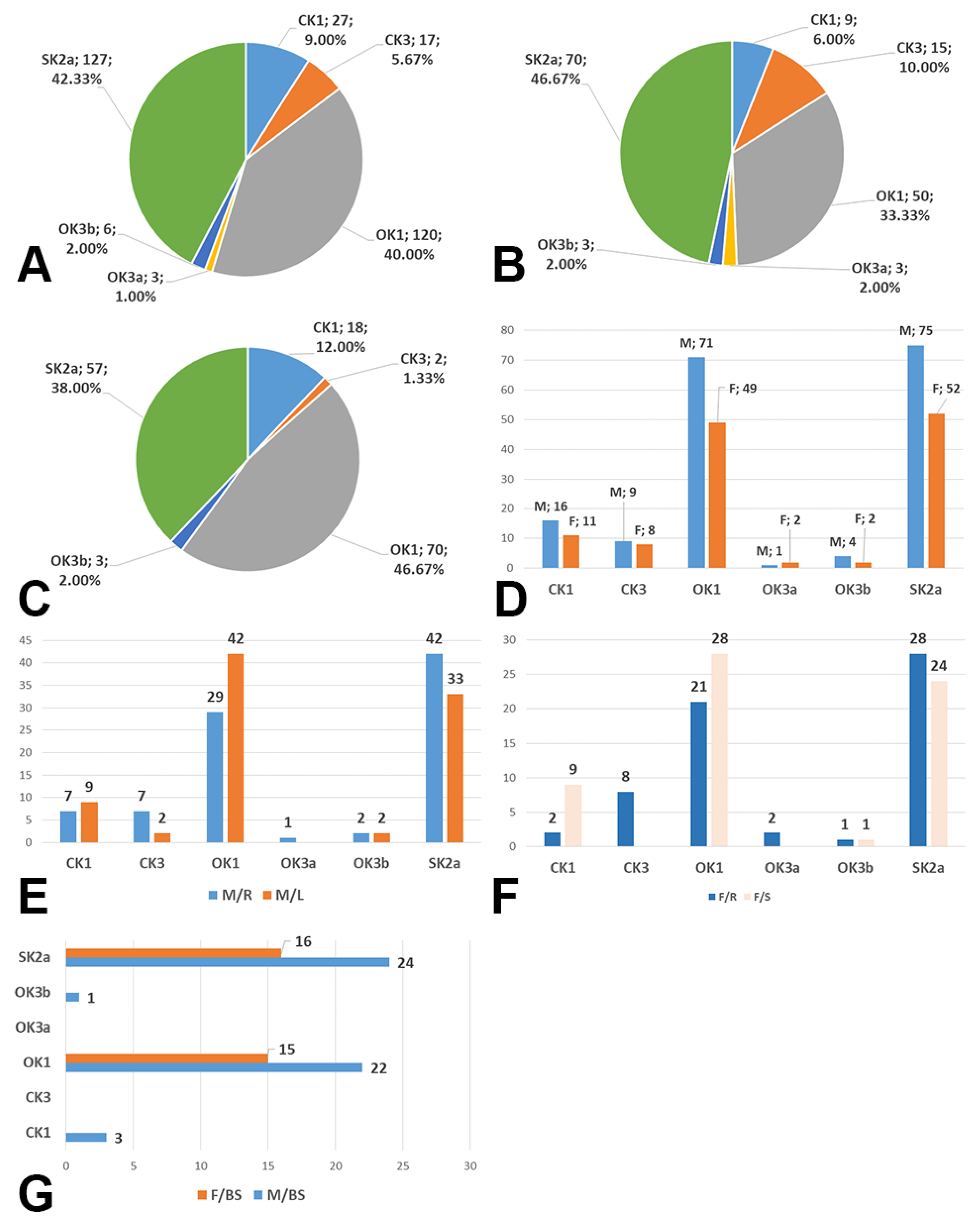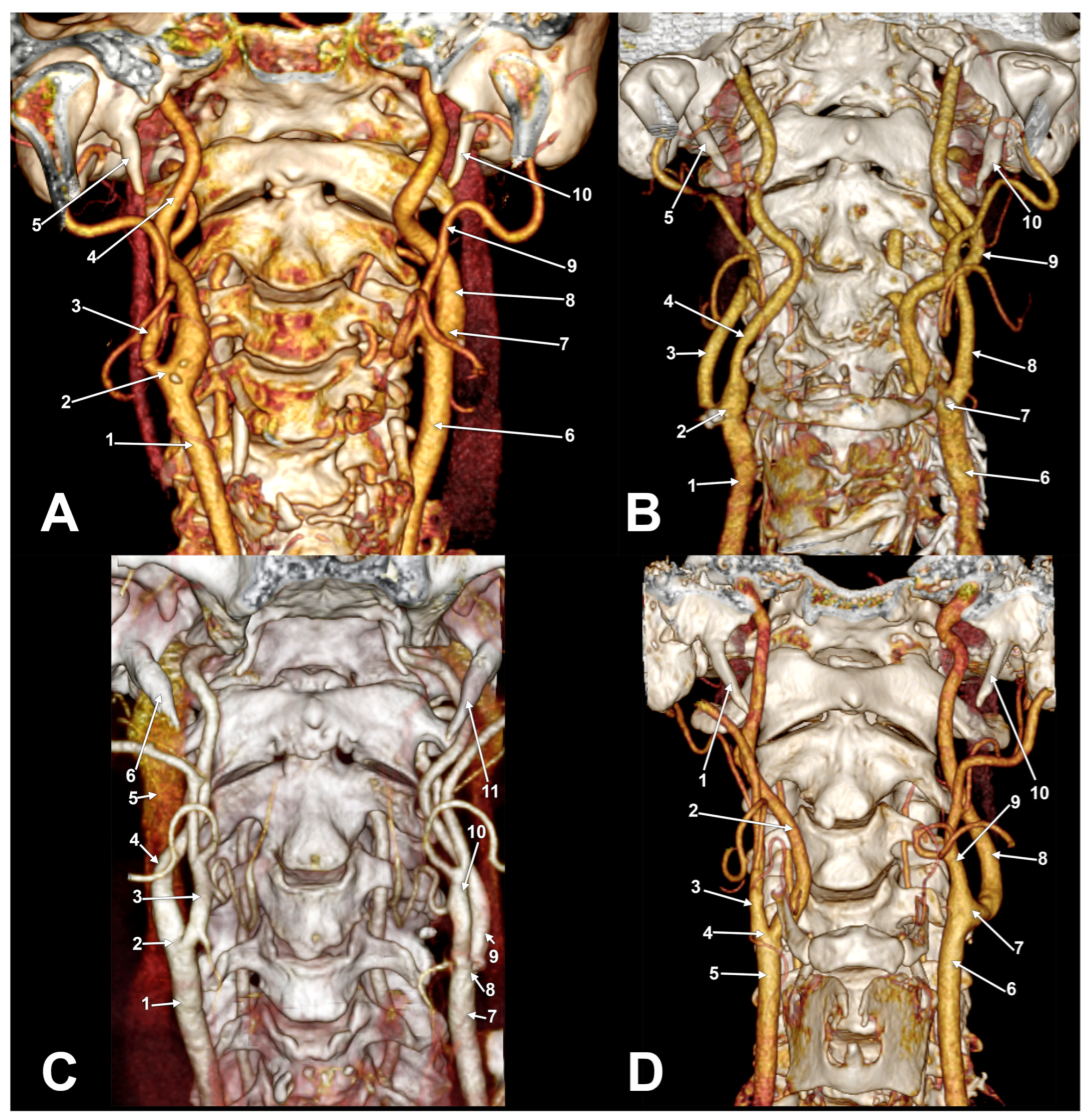The Axial Spin of the Carotid Bifurcation
Abstract
1. Introduction
2. Materials and Methods
3. Results
4. Discussion
5. Conclusions
Author Contributions
Funding
Institutional Review Board Statement
Informed Consent Statement
Data Availability Statement
Conflicts of Interest
References
- Gray, H.; Standring, S.; Anand, N.; Birch, R.; Collins, P.; Crossman, A.; Gleeson, M.; Jawaheer, G.; Smith, A.L.; Spratt, J.D.; et al. Gray’s Anatomy: The Anatomical Basis of Clinical Practice; Elsevier: London, UK, 2016. [Google Scholar]
- Delic, J.; Bajtarevic, A.; Isakovic, E. Positional variations of the external and the internal carotid artery. Acta Med. Salin. 2009, 39, 86–89. [Google Scholar] [CrossRef][Green Version]
- Prendes, J.L.; McKinney, W.M.; Buonanno, F.S.; Jones, A.M. Anatomic variations of the carotid bifurcation affecting doppler scan interpretation. J. Clin. Ultrasound 1980, 8, 147–150. [Google Scholar] [CrossRef] [PubMed]
- Żytkowski, A.; Tubbs, R.S.; Iwanaga, J.; Clarke, E.; Polguj, M.; Wysiadecki, G. Anatomical normality and variability: Historical perspective and methodological considerations. Transl. Res. Anat. 2021, 23, 100105. [Google Scholar] [CrossRef]
- Kowalczyk, K.A.; Majewski, A. Analysis of surgical errors associated with anatomical variations clinically relevant in general surgery. Review of the literature. Transl. Res. Anat. 2021, 23, 100107. [Google Scholar] [CrossRef]
- Rao, S.; Vollala, V.R.; Rao, M.; Samuel, V.P.; Deepthinath, D.; Nayak, S.; Pamidi, N. Unusual position of external carotid artery: A case report. Indian J. Plast. Surg. 2005, 38, 170–171. [Google Scholar] [CrossRef]
- Kamide, T.; Nomura, M.; Tamase, A.; Mori, K.; Seki, S.; Kitamura, Y.; Nakada, M. Simple classification of carotid bifurcation: Is it possible to predict twisted carotid artery during carotid endarterectomy? Acta Neurochir. 2016, 158, 2393–2397. [Google Scholar] [CrossRef] [PubMed]
- Rusu, M.C.; Jianu, A.M.; Manta, B.A.; Hostiuc, S. Aortic Origins of the Celiac Trunk and Superior Mesenteric Artery. Diagnostics 2021, 11, 1111. [Google Scholar] [CrossRef]
- Minca, D.I.; Rusu, M.C.; Radoi, P.M.; Vrapciu, A.D.; Hostiuc, S.; Toader, C. The Infraoptic or Infrachiasmatic Course of the Anterior Cerebral Artery Emerging an Elongated Internal Carotid Artery. Tomography 2022, 8, 2243–2255. [Google Scholar] [CrossRef]
- Salvador, J.T.; Tarnoff, J.; Feinhandler, E. Difficult lesions of the carotid arteries and their surgical management. Angiology 1977, 28, 500–514. [Google Scholar] [CrossRef]
- Gailloud, P.; Murphy, K.J.; Rigamonti, D. Bilateral thoracic bifurcation of the common carotid artery associated with Klippel-Feil anomaly. AJNR Am. J. Neuroradiol. 2000, 21, 941–944. [Google Scholar]
- Gluncic, V.; Petanjek, Z.; Marusic, A.; Gluncic, I. High bifurcation of common carotid artery, anomalous origin of ascending pharyngeal artery and anomalous branching pattern of external carotid artery. Surg. Radiol. Anat. 2001, 23, 123–125. [Google Scholar] [CrossRef] [PubMed]
- Gomez, C.K.; Arnuk, O.J. Intrathoracic bifurcation of the right common carotid artery. BMJ Case Rep. 2013, 2013, bcr2012007554. [Google Scholar] [CrossRef] [PubMed]
- Ueda, S.; Kohyama, Y.; Takase, K. Peripheral hypoglossal nerve palsy caused by lateral position of the external carotid artery and an abnormally high position of bifurcation of the external and internal carotid arteries—A case report. Stroke 1984, 15, 736–739. [Google Scholar] [CrossRef] [PubMed]
- Deshpande, S.H.; Nuchhi, A.B.; Bannur, B.M.; Patil, B.G. Bilateral Multiple Variations in Carotid Arteries-A Case Report. J. Clin. Diagn. Res. 2015, 9, AD01–AD03. [Google Scholar] [CrossRef] [PubMed]
- Manta, M.D.; Rusu, M.C.; Hostiuc, S.; Vrapciu, A.D.; Manta, B.A.; Jianu, A.M. The Carotid-Hyoid Topography Is Variable. Medicina 2023, 59, 1494. [Google Scholar] [CrossRef] [PubMed]
- Acar, M.; Salbacak, A.; Sakarya, M.E.; Zararsiz, I.; Ulusoy, M. Análisis Morfométrico de la Arteria Carótida Externa y sus Ramas Mediante la Técnica de Angiografía por Tomografía Computarizada Multidetector. Int. J. Morphol. 2013, 31, 1407–1414. [Google Scholar] [CrossRef]
- Anangwe, D.; Saidi, H.; Ogeng’o, J.; Awori, K.O. Anatomical variations of the carotid arteries in adult Kenyans. East. Afr. Med. J. 2008, 85, 244–247. [Google Scholar] [CrossRef] [PubMed]
- Anu, V.R.; Pai, M.M.; Rajalakshmi, R.; Latha, V.P.; Rajanigandha, V.; D’Costa, S. Clinically-relevant variations of the carotid arterial system. Singap. Med. J. 2007, 48, 566–569. [Google Scholar]
- Chalise, U.; Pradhan, A.; Lama, C.P.; Dhungel, S. Bifurcation of common carotid artery in relation to vertebral level in Nepalese: A cadaveric study. Nepal Med. Coll. J. 2021, 23, 223–227. [Google Scholar] [CrossRef]
- Cihan, O.F.; Deveci, K. Topography of the Anatomical Landmarks of Carotid Bifurcation and Clinical Significance. Cureus 2022, 14, e31715. [Google Scholar]
- Hayashi, N.; Hori, E.; Ohtani, Y.; Ohtani, O.; Kuwayama, N.; Endo, S. Surgical anatomy of the cervical carotid artery for carotid endarterectomy. Neurol. Med. Chir. 2005, 45, 25–29, discussion 30. [Google Scholar] [CrossRef]
- Kurkcuoglu, A.; Aytekin, C.; Oktem, H.; Pelin, C. Morphological variation of carotid artery bifurcation level in digital angiography. Folia Morphol. 2015, 74, 206–211. [Google Scholar] [CrossRef] [PubMed]
- McAfee, D.K.; Anson, B.J.; McDonald, J.J. Variation in the point of bifurcation of the common carotid artery. Q. Bull. Northwest Univ. Med. Sch. 1953, 27, 226–229. [Google Scholar]
- Mirjalili, S.A.; McFadden, S.L.; Buckenham, T.; Stringer, M.D. Vertebral levels of key landmarks in the neck. Clin. Anat. 2012, 25, 851–857. [Google Scholar] [CrossRef] [PubMed]
- Mompeó, B.; Bajo, E. Carotid bifurcation: Clinical relevance. Eur. J. Anat. 2015, 19, 37–42. [Google Scholar]
- Honda, M.; Maeda, H. Analysis of twisted internal carotid arteries in carotid endarterectomy. Surg. Neurol. Int. 2020, 11, 147. [Google Scholar] [CrossRef]
- Marcucci, G.; Accrocca, F.; Gabrielli, R.; Antonelli, R.; Giordano, A.G.; De Vivo, G.; Siani, A. Complete transposition of carotid bifurcation: Can it be an additional risk factor of injury to the cranial nerves during carotid endarterectomy? Interact. Cardiovasc. Thorac. Surg. 2011, 13, 471–474. [Google Scholar] [CrossRef]
- Teal, J.S.; Rumbaugh, C.L.; Bergeron, R.T.; Segall, H.D. Lateral position of the external carotid artery: A rare anomaly? Radiology 1973, 108, 77–81. [Google Scholar] [CrossRef]
- Uchino, A.; Tsuzuki, N. Newly developed twisted carotid bifurcation on the left side incidentally diagnosed by magnetic resonance angiography. Radiol. Case Rep. 2023, 18, 339–342. [Google Scholar] [CrossRef]
- Ito, M.; Niiya, Y.; Kojima, M.; Itosaka, H.; Iwasaki, M.; Kazumata, K.; Mabuchi, S.; Houkin, K. Lateral Position of the External Carotid Artery: A Rare Variation to Be Recognized During Carotid Endarterectomy. Acta Neurochir. Suppl. 2016, 123, 115–122. [Google Scholar]
- Tokugawa, J.; Kudo, K.; Mitsuhashi, T.; Mitsuhashi, T.; Hishii, M. Older age, carotid artery stenosis, and female sex as factors correlated with twisted carotid bifurcation based on 457 angiographic studies. Clin. Neurol. Neurosurg. 2023, 233, 107902. [Google Scholar] [CrossRef]
- Katano, H.; Yamada, K. Carotid endarterectomy for stenoses of twisted carotid bifurcations. World Neurosurg. 2010, 73, 147–154, discussion e121. [Google Scholar] [CrossRef] [PubMed]
- Bailey, M.; Scott, D.; Tunstall, R.; Gough, M. Lateral external carotid artery: Implications for the vascular surgeon. Eur. J. Vasc. Endovasc. Surg. 2007, 14, 22–24. [Google Scholar]
- Bussaka, H.; Sato, N.; Oguni, T.; Korogi, M.; Yamashita, Y.; Takahashi, M. Lateral position of the external carotid artery. Rinsho Hoshasen 1990, 35, 1061–1063. [Google Scholar] [PubMed]
- Lukins, D.E.; Pilati, S.; Escott, E.J. The Moving Carotid Artery: A Retrospective Review of the Retropharyngeal Carotid Artery and the Incidence of Positional Changes on Serial Studies. AJNR Am. J. Neuroradiol. 2016, 37, 336–341. [Google Scholar] [CrossRef]
- Rusu, M.C.; Vasilescu, A.; Nimigean, V. A rare anatomic variant: The lateral position of the external carotid artery. Int. J. Oral. Maxillofac. Surg. 2006, 35, 1066–1067. [Google Scholar] [CrossRef]
- Handa, J.; Matsuda, M.; Handa, H. Lateral position of the external carotid artery. Report of a case. Radiology 1972, 102, 361–362. [Google Scholar] [CrossRef] [PubMed]
- Kirchgessner, A. Lateral external carotid artery and linguofacial trunk: A rare anatomic variant. MOJ Anat. Physiol. 2015, 1, 1–3. [Google Scholar] [CrossRef]
- Hayashi, K.; Matsunaga, Y.; Hayashi, Y.; Shirakawa, K.; Iwanaga, M. A Case of Carotid Endarterectomy for the Internal Carotid Artery Stenosis Associated with Twisted Internal Carotid Artery. No Shinkei Geka 2019, 47, 455–460. [Google Scholar]
- Sanderson, J.; Swail, C.; Gamez, M.; Chalk, R.; Sharma, R.; Bhattacharya, A. Triple variation in the vascular supply in the neck of a female donor body: A case report. Surg. Radiol. Anat. 2022, 44, 1481–1484. [Google Scholar] [CrossRef] [PubMed]
- Braeuer, N.R.; Mallamo, J.T.; Lynch, R.D. Anomalous lateral and inferior position of the external carotid artery: Case report. J. Can. Assoc. Radiol. 1975, 26, 210–211. [Google Scholar] [PubMed]
- Gayathri, L.; Jesudas, V.V. The cadaveric study of the lateral position of the external carotid artery. World J. Pharm. Sci. 2019, 7, 82–85. [Google Scholar]
- Trigaux, J.P.; Delchambre, F.; Van Beers, B. Anatomical variations of the carotid bifurcation: Implications for digital subtraction angiography and ultrasonography. Br. J. Radiol. 1990, 63, 181–185. [Google Scholar] [CrossRef]
- Paulsen, F.; Tillmann, B.; Christofides, C.; Richter, W.; Koebke, J. Curving and looping of the internal carotid artery in relation to the pharynx: Frequency, embryology and clinical implications. J. Anat. 2000, 197 Pt 3, 373–381. [Google Scholar] [CrossRef]
- Radak, D.; Davidovic, L.; Tanaskovic, S.; Banzic, I.; Matic, P.; Babic, S.; Kostic, D.; Isenovic, E.R. A tailored approach to operative repair of extracranial carotid aneurysms based on anatomic types and kinks. Am. J. Surg. 2014, 208, 235–242. [Google Scholar] [CrossRef]
- Raidah, A.; Jaramillo, N.; Serena, G.; Lev, S.; Ramanathan, A. Tortuous Carotid Arteries and Their Clinical Implications: A Report of Two Cases. Cureus 2023, 15, e36953. [Google Scholar] [CrossRef]
- Uno, M.; Yagi, K.; Takai, H.; Hara, K.; Oyama, N.; Yagita, Y.; Matsubara, S. Diagnosis and Operative Management of Carotid Endarterectomy in Patients with Twisted Carotid Bifurcation. Neurol. Med. Chir. 2020, 60, 383–389. [Google Scholar] [CrossRef] [PubMed]
- Schulz, U.G.; Rothwell, P.M. Major variation in carotid bifurcation anatomy: A possible risk factor for plaque development? Stroke 2001, 32, 2522–2529. [Google Scholar] [CrossRef]
- Seong, J.; Lieber, B.B.; Wakhloo, A.K. Morphological age-dependent development of the human carotid bifurcation. J. Biomech. 2005, 38, 453–465. [Google Scholar] [CrossRef]
- Takai, H.; Matsubara, S.; Minami-Ogawa, Y.; Hirai, S.; Shikata, E.; Yagi, K.; Oyama, N.; Yagita, Y.; Uno, M. Association between Carotid Bifurcation Angle and Vulnerable Plaque Volume Using Black Blood Magnetic Resonance Imaging. Neurol. Med. Chir. 2023. [Google Scholar] [CrossRef]
- Kuwada, C.; Mannion, K.; Aulino, J.M.; Kanekar, S.G. Imaging of the carotid space. Otolaryngol. Clin. N. Am. 2012, 45, 1273–1292. [Google Scholar] [CrossRef] [PubMed]





Disclaimer/Publisher’s Note: The statements, opinions and data contained in all publications are solely those of the individual author(s) and contributor(s) and not of MDPI and/or the editor(s). MDPI and/or the editor(s) disclaim responsibility for any injury to people or property resulting from any ideas, methods, instructions or products referred to in the content. |
© 2023 by the authors. Licensee MDPI, Basel, Switzerland. This article is an open access article distributed under the terms and conditions of the Creative Commons Attribution (CC BY) license (https://creativecommons.org/licenses/by/4.0/).
Share and Cite
Manta, M.D.; Rusu, M.C.; Hostiuc, S.; Vrapciu, A.D.; Manta, B.A.; Jianu, A.M. The Axial Spin of the Carotid Bifurcation. Diagnostics 2023, 13, 3122. https://doi.org/10.3390/diagnostics13193122
Manta MD, Rusu MC, Hostiuc S, Vrapciu AD, Manta BA, Jianu AM. The Axial Spin of the Carotid Bifurcation. Diagnostics. 2023; 13(19):3122. https://doi.org/10.3390/diagnostics13193122
Chicago/Turabian StyleManta, Mihaela Daniela, Mugurel Constantin Rusu, Sorin Hostiuc, Alexandra Diana Vrapciu, Bogdan Adrian Manta, and Adelina Maria Jianu. 2023. "The Axial Spin of the Carotid Bifurcation" Diagnostics 13, no. 19: 3122. https://doi.org/10.3390/diagnostics13193122
APA StyleManta, M. D., Rusu, M. C., Hostiuc, S., Vrapciu, A. D., Manta, B. A., & Jianu, A. M. (2023). The Axial Spin of the Carotid Bifurcation. Diagnostics, 13(19), 3122. https://doi.org/10.3390/diagnostics13193122







